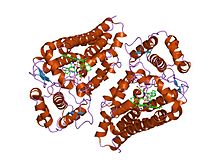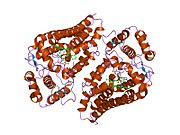Indoleamine 2,3-dioxygenase
Ensembl | |||||||||
|---|---|---|---|---|---|---|---|---|---|
| UniProt | |||||||||
| RefSeq (mRNA) | |||||||||
| RefSeq (protein) | |||||||||
| Location (UCSC) | Chr 8: 39.9 – 39.93 Mb | Chr 8: 25.07 – 25.09 Mb | |||||||
| PubMed search | [3] | [4] | |||||||
| View/Edit Human | View/Edit Mouse |
| Indoleamine 2,3-dioxygenase | |||||||||
|---|---|---|---|---|---|---|---|---|---|
 crystal structure of 4-phenylimidazole bound form of human indoleamine 2,3-dioxygenase | |||||||||
| Identifiers | |||||||||
| Symbol | IDO | ||||||||
| Pfam | PF01231 | ||||||||
| Pfam clan | CL0380 | ||||||||
| InterPro | IPR000898 | ||||||||
| PROSITE | PDOC00684 | ||||||||
| |||||||||
| Indoleamine 2,3-dioxygenase | |||||||||
|---|---|---|---|---|---|---|---|---|---|
| Identifiers | |||||||||
ExPASy | NiceZyme view | ||||||||
| KEGG | KEGG entry | ||||||||
| MetaCyc | metabolic pathway | ||||||||
| PRIAM | profile | ||||||||
| PDB structures | RCSB PDB PDBe PDBsum | ||||||||
| Gene Ontology | AmiGO / QuickGO | ||||||||
| |||||||||
Indoleamine-pyrrole 2,3-dioxygenase (IDO or INDO
Physiological function
Indoleamine 2,3-dioxygenase is the first and rate-limiting enzyme of tryptophan catabolism through the kynurenine pathway.
IDO is an important molecule in the mechanisms of tolerance and its physiological functions include the suppression of potentially dangerous
One of the organs with high IDO expression is the placenta. In the 1990s, the immunosuppressive function of this enzyme was first described in mice due to the study of placental tryptophan metabolism. Thus, mammalian placenta, due to intensive tryptophan catabolism has the ability to suppress T cell activity, thereby contributing to its position of immunologically privileged tissue.[21]
Clinical significance
IDO is an
These mechanisms are crucial in the process of
Emerging clinical studies suggest that combination of IDO inhibitors with classical
Inhibitors
Epacadostat (INCB24360), navoximod (GDC-0919), and linrodostat (BMS-986205) are potent inhibitors of the indoleamine 2,3-dioxygenase enzyme and are in clinical trials for various cancers.
See also
References
- ^ a b c GRCh38: Ensembl release 89: ENSG00000131203 – Ensembl, May 2017
- ^ a b c GRCm38: Ensembl release 89: ENSMUSG00000031551 – Ensembl, May 2017
- ^ "Human PubMed Reference:". National Center for Biotechnology Information, U.S. National Library of Medicine.
- ^ "Mouse PubMed Reference:". National Center for Biotechnology Information, U.S. National Library of Medicine.
- PMID 3877502.
- ^ "Entrez Gene: INDO indoleamine-pyrrole 2,3 dioxygenase".
- PMID 25477879.
- PMID 27547037.
- PMID 279015.
- PMID 291064.
- PMID 23103127.
- ^ PMID 24711084.
- PMID 26839260.
- S2CID 10618102.
- S2CID 61156683.
- S2CID 4391121.
- PMID 29163470.
- PMID 9728563.
- PMID 14963171.
- PMID 15919929.
- PMID 9712583.
- PMID 26674411.
- PMID 10224276.
- PMID 12186838.
- ISSN 0531-5131.
- PMID 20350764.
- S2CID 10618102.
- PMID 25686005.
- S2CID 12338548.
- PMID 25686005.
- PMID 30134237.
External links
- Indoleamine-Pyrrole+2,3,-Dioxygenase at the U.S. National Library of Medicine Medical Subject Headings (MeSH)
- PDBe-KB provides an overview of all the structure information available in the PDB for Human Indoleamine 2,3-dioxygenase 1


